Everyday tech, intimacy & illusion
Andrew Fuhrmann: Vanitas, Are We The One?, Alter, The Naked Self, Programmed to Reproduce, Sex and Death, Erotic Dance, i might blow up someday
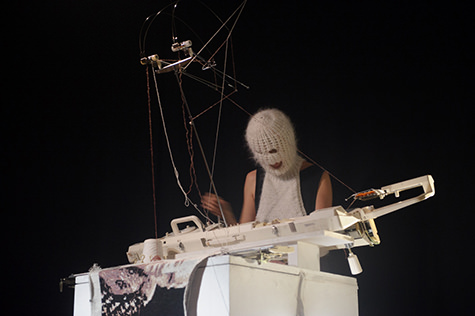
Programmed to Reproduce, Casey Jenkins, Festival of Live Art, Arts House
photo Sarah Walker
Programmed to Reproduce, Casey Jenkins, Festival of Live Art, Arts House
Welcome to the Festival of Live Art at the North Melbourne Town Hall, where tablet computers and mobile devices are as numerous and conspicuous as on any peak-hour public transport commute. And why not, when so many of our day-to-day exchanges—from the most impersonal to the most intimate – are mediated by hand-held digital technologies? There’s no avoiding it: art inevitably reflects the culture of its time, not only in its content but in its expression.
Vanitas
And so we have Vanitas, written and performed by Robert Walton and Jason Maling, a very well put-together, mostly involving audio adventure for smartphones. It’s part art history lesson, part procedural drama, a story about impermanence, incompletion, imperfection and flowers. In the first three episodes, listeners are introduced to the curious tale of an abandoned flower shop around the corner from the Town Hall. The mystery recalls Adam Beckman’s very popular This American Life story “The House on Loon Lake,” with the difference that here you can actually visit the shop while listening.
To further extend the basic podcast format, participants also receive emails, text messages and robocalls between episodes. And it’s all very intriguing, up to a point, but also a little unsettling. With its somewhat arch mingling of fact, fiction and philosophical reflection, you’re never quite sure where you stand with Vanitas, never quite sure how much of it is documentary and how much fabulation.
Are We The One?
There’s intrigue, too, in Are We the One?, devised by Keith Armstrong and David Finnigan, a work that outwardly resembles an elaborate blind date. Two participants, unknown to each other and stationed in different rooms, are invited to create unique walking experiences for one another in and around the Town Hall using a custom-built smartphone app. During this gentle perambulation, personal information is exchanged via the app until, finally, at the end of the route, you have the option of stooping into the flesh and actually meeting in person.
Alter
Then, swapping smartphones for tablets, there’s Alter, a participatory installation piece for 16 iPads. Performance maker Tamara Saulwick and composer Peter Knight have created a meditative, slightly muted audiovisual experience in which audience members place softly glowing tablets in various positions around a large darkened room, creating an ethereal surround-sound symphony of faint murmurs, rustling crepitations and soothing hiss. It’s a subtle work, so subtle that it might at first appear slight, but one that, in that pale, strangely comforting light, does create a real, if fleeting, sense of shared intimacy.
The Naked Self
Sharing and intimacy is also the theme of Tanya Dickson and Michele Lee’s The Naked Self. In the first part of the work, armed with tablet and headphones, audience members listen to recordings of other participants telling stories and confessing details about their bodies. The archive through which these small acts of self-exposure are accessed is very easy to use and it all looks incredibly slick. Indeed, the overall design of the work is so simple and streamlined that full participation seems somehow inevitable, almost as if there were no way to opt out. And so it is that, in the second part of the work, you find yourself naked in a soundproofed cubicle, staring into a mirror, composing your own audio self-portrait.
How you feel about The Naked Self will probably depend on how you feel about the current culture of over-sharing more generally, and about the way in which new technologies variously encourage or contour narcissistic and voyeuristic impulses. But while some participants will no doubt find it a bit discomforting, it would be wrong to call the work transgressive or deliberately confrontational. It is in fact only a canny re-staging of the way in which social media is already used, particularly on hand-held devices. What else is the bathroom mirror selfie if not a confession of the naked self?
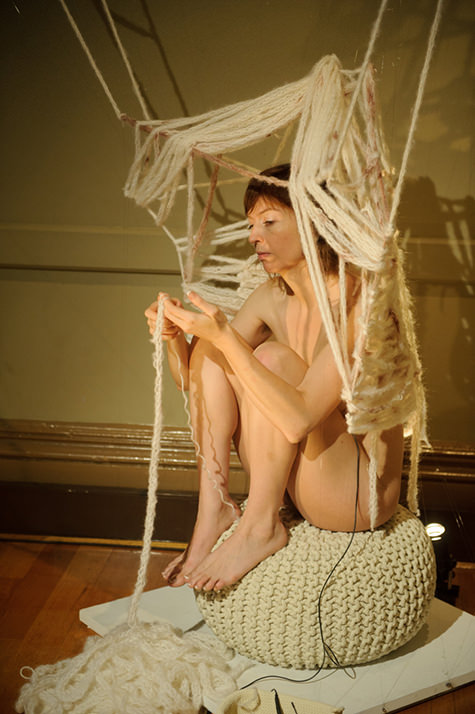
Programmed to Reproduce, Festival of Live Art, Arts House
photo Sarah Walker
Programmed to Reproduce, Festival of Live Art, Arts House
Programmed to Reproduce
Casey Jenkins’ Programmed to Reproduce is a sort of sequel to Cast Off My Womb, the 2013 durational performance piece in which Jenkins knitted a continuous scarf from yarn lodged in her vagina. The new work again involves vaginal knitting, this time in the construction of a large womb-like installation. As she knits, a monitor on the opposite side of the room plays a looped recording of Jenkins reading in a calm monotone a lengthy compilation of abusive comments posted online about the original work. It’s a simple set-up, but effective. The contrast between the bullying, conformist litany and Jenkins’ quiet but persistent industry is unexpectedly moving—perhaps even inspirational.
The relationship between Cast Off My Womb and Programmed to Reproduce points to an important though rarely acknowledged formal difference between performance art and live art. Where performance art typically involves a degree of provocation or shock, whether pushing boundaries or confusing expectations, live art tends to be more exploratory or contemplative, mapping patterns of social interaction or looking at ways to register or illustrate contemporary values and beliefs as performance. So, while both art forms are interdisciplinary and deal with problems around presence and participation, live art tends to be more research oriented, and not necessarily an artist’s primary creative practice.
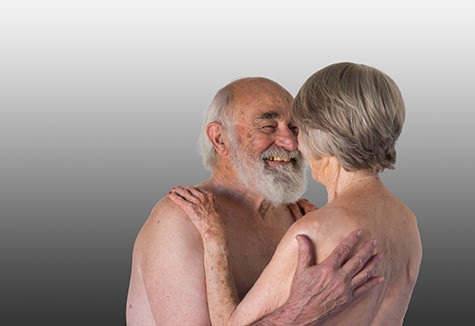
Sex and Death, Festival of Live Art
photo Poncho Hawkes
Sex and Death, Festival of Live Art
Sex and Death
Contemplation is certainly the dominant mood of Samara Hersch’s Sex and Death, a playful work about the way we think about—or don’t think about—ageing. The first part involves a one-on-one interview with someone older and perhaps wiser at a nearby pub, where stories are swapped and life’s mystery is wondered at over a beer and a stack of cue cards. In the second part, audience members are offered the chance to get in on the current fad for recreating old childhood photographs: a fun way of emphasising not only the ways in which the body changes over time, but also the unexpected ways in which it stays the same.
Erotic Dance
But, of course, live art is only a category of convenience, and there is always leakage and contamination and overlap. Luke George’s Erotic Dance, for instance, appears to be a conventional dance piece, with a seated audience facing the front of the performance space, attentive but essentially passive. Sound designer Nick Roux poses languidly centrestage, propped on one elbow, his back to the audience, surrounded by effects pedals. As if to highlight just how traditional this set-up is, he lies before a long mirror, looking obliquely back at the audience, like the Venus of Velázquez.
As the ambient hum of an electric guitar lying to one side begins to swell and churn, George at last emerges from the front row of the audience, stumbling forward, as if drawn into the painting. Gradually shedding his clothes, he pushes his body through brief phrases and trance-like loops, moving faster and faster as the noise intensifies.
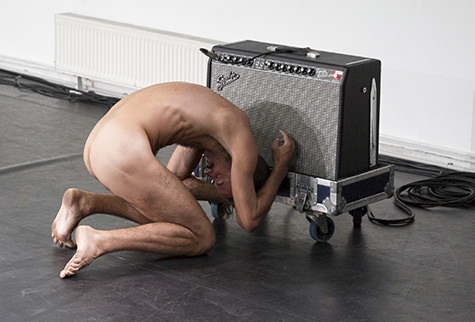
Erotic Dance, Luke George, Nick Roux, Festival of Live Art, Arts House
photo Pierre Grobois
Erotic Dance, Luke George, Nick Roux, Festival of Live Art, Arts House
George cites Susan Sontag’s call for an arts criticism that is also a kind of erotics as the inspiration for this work. The question seems to be whether a purely sensual way of experiencing art can be translated into dance. Perhaps, then, his orgiastic plunge into a throbbing wall of distortion, his body convulsed between two amplifiers, is meant as a response to Velázquez?, or a representation of how he feels about Velázquez?
But what of the audience, witnesses to this sensual homage? In terms of the work’s eroticism, once again we are in the position of voyeurs. And it is interesting that, after an evening spent negotiating various digital hand-held devices, it is easy, perhaps too easy, to imagine that what is happening on stage is actually playing out behind a glass screen.
i might blow up someday
Fittingly, then, the last show on the North Melbourne Town Hall program in week one of the festival is i might blow up someday by Sydney’s Hissy Fit (Jade Muratore, Emily O’Connor and Nat Randall), an art punk performance concert combining glam rock theatrics and mosh pit anarchy. It’s an earnest attempt to smash the screen, reconstructing and redeploying the idea of female hysteria to disrupt voyeuristic habits of spectatorship and involve the audience in a sweaty free-for-all.
The attempt is only partially successful. Most audience members remain impassive, unwilling to join in the mayhem. But even where it fails, i might blow up someday seems like a sort of victory: finally, something that is unacceptable, something that can be refused, something that is more than just a reflection of the everyday and the banal. Something that is also a demand, however unappealing.
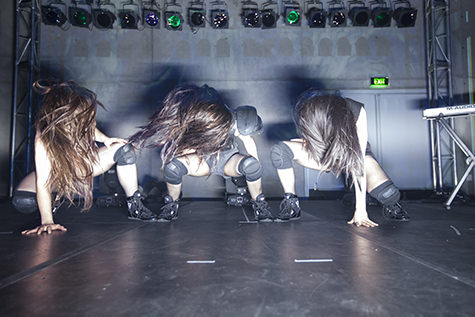
I Might Blow Up Some Day, Hissy Fit
photo Alex Davies
I Might Blow Up Some Day, Hissy Fit
–
Festival of Live Art 2016, Arts House, North Melbourne Town Hall, Week 1, 1-12 March
RealTime issue #131 Feb-March 2016, web






